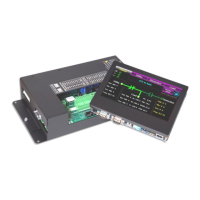2.12. COMMUNICATION CABLE INSTALLATION
Communication cable wiring from the controller’s communication port must be suitably routed
to protect it from sources of electrical interference. Guidelines for protection against possible
electrical interference are as follows:
• Use high quality, shielded cable only with drain wire grounded at the controller end
only.
• Route the communication cable at least 3 M (10’) away from sources of electrical
noise such as variable speed motor drives, high voltage power conductors, UPS
systems, transformers, rectifiers etc.
• Use separate, dedicated conduit runs for all communication cables. Do not tightly
bundle communication cables together in the conduit. Conduit should be
ferromagnetic type near sources of possible electrical interference. The entire length
of conduit should be grounded to building earth ground.
• When communication cables must cross over low or high voltage AC power
conductors, the communication cables must cross at right angles and not in parallel
with the conductors.
For additional information on protection against electrical interference, contact
THOMSON POWER SYSTEMS factory.
2.13. DIELECTRIC TESTING
Do not perform any high voltage dielectric testing on the transfer switch with the TSC 900
controller connected into the circuit, as serious damage will occur to the controller. All AC control
fuses or control/sensing circuit isolation plugs connected to the TSC 900 must be
removed/disconnected if high voltage dielectric testing is performed on the transfer switch.

